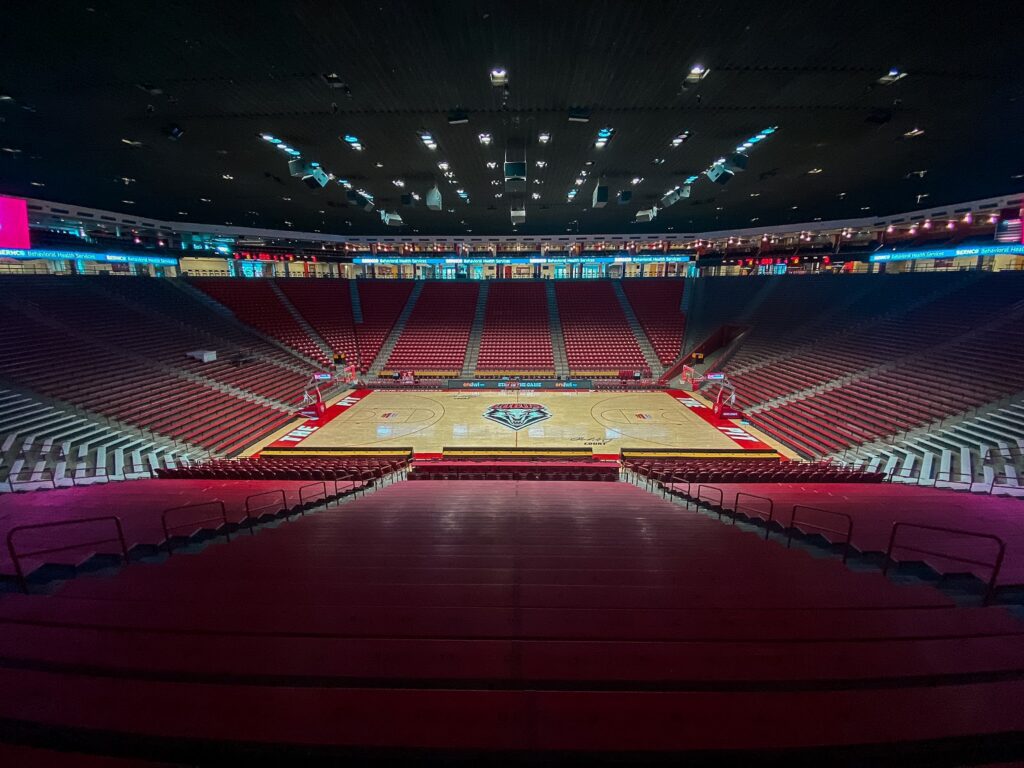The University of New Mexico’s (UNM) basketball arena is affectionately called “The Pit” because its floor is 37 feet below ground level, not because it is in bad condition. Well, at least not anymore. Built in 1966, the building, with its unique underground design, had lost enough of its mid-century luster by the early 2000s.
Despite being one of the most fabled and loudest venues in college basketball, The Pit, officially known as University Arena, found itself at the crossroads of being torn down or revitalized. The university chose the latter and wound up with a widely praised, impressively sustainable, modernized sports facility.

In the new design, a glass “skin” wrapped around the exterior, giving the arena a spectacular look, with areas of the original building visible to the public. However, the changes to the venue were more than having a nicer appearance. The multimillion-dollar undertaking delivered improvements inside and out, including many notably green in nature.
“Nothing is more sustainable than reuse of an existing facility,” stated John Pate, vice president of architecture with MolzenCorbin, the firm behind The Pit’s redesign. “Saving the building from demolition while preserving its cherished atmosphere set up conditions to accomplish the most sustainable of design and construction efforts: Reimagining an exciting sports venue, reusing all that was good, and integrating new sustainable technologies.”
The decision not to tear down The Pit was the first sustainably-minded step, as it avoided the creation of demolition-related pollution.
Others included diverting more than 95% of construction waste from landfills and having almost a quarter of the architectural, site, and structural materials contain regionally sourced components. Furthermore, more than 20% of those materials used pre- and post-consumer recycled materials, including 100% of the concrete and asphalt base courses (the first layer underneath pavement) and 95% of the structural steel.

The carpeting selected adhered to the Carpet & Rug Institute’s Green Label Plus program criteria to produce a healthy indoor environment. Construction products, like paints, adhesives, and sealants, held zero or extremely low volatile organic compounds. The composite wood products also contained no added urea formaldehyde, a commonly used wood adhesive that emits harmful formaldehyde emissions.
The university’s interest in sustainability was similarly reflected in the arena’s surrounding grounds, which added up to 7.5 acres of permanent open space. The landscaping’s emphasis on native and water-wise plants combined with new irrigation systems to consume approximately 70% less water compared to standard practices. Ponds were created to filter stormwater and consequently improve water quality.
The outdoor design included bike paths, secure bike racks, and preferred parking spaces for low-emitting fuel-efficient vehicles. All these additions encourage people to choose alternative transportation over less eco-friendly gasoline-based cars.

The Pit’s makeover was particularly beneficial regarding the facility’s utilities systems.
Putting in more efficient plumbing fixtures helped to lower indoor water consumption by nearly half.
Energy conservation increased through a broad range of changes. Lighting controls, high-performance windows, upgraded HVAC systems, and Energy Star-qualified white roofing decreased solar heat gain.
These improvements were estimated to drop energy usage by nearly 14% and utility costs by over 20% compared to standard practice designs. In other words, these reductions would match powering 33 homes for a year while the avoided carbon dioxide emissions equaled planting 10,037 trees.
The extraordinary renovation led the U.S. Green Building Council (USGBC) to award The Pit with a Silver certification for Leadership In Energy and Environmental Design (LEED). The USGBC also featured the arena as one of the three college athletic facilities spotlighted in a 2017 LEED in Motion: Venues report.
The accolades didn’t stop with the USGBC. The arena also picked up the Chairman’s Award from the New Mexico chapter of the National Association of Industrial and Office Properties (NAIOP). It also got the Engineering News-Record Southwest’s Best Projects Award of Merit in the Sports/Entertainment category.

The Pit’s accomplishments represent only part of the UNM’s Athletic Department’s mission to “support the University of New Mexico’s core value in sustainability,” according to the Go Lobos website. The measures the department has taken include switching the football field from grass to turf to save water, installing high-efficient lights at its baseball field, and participating in recycling efforts. These efforts were all while “actively searching for additional sustainable practices to incorporate into daily operations.”





